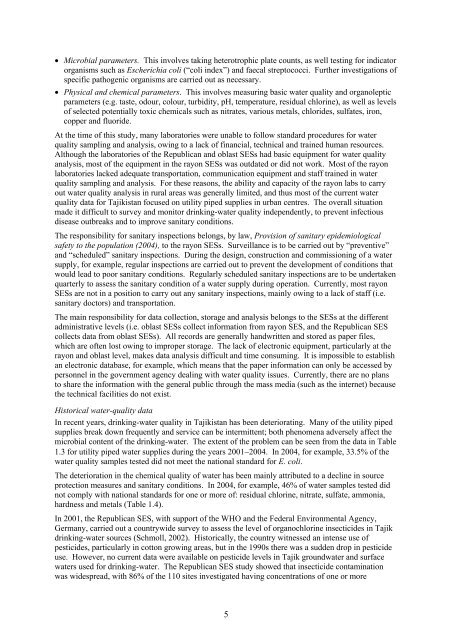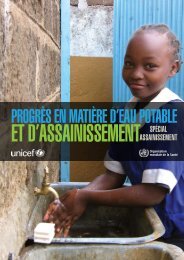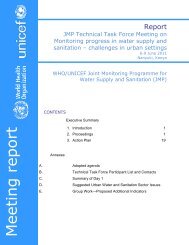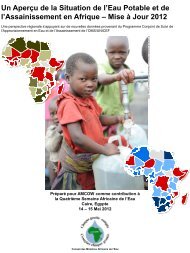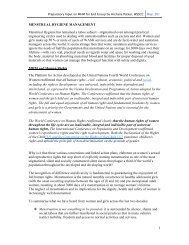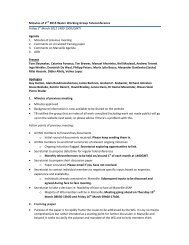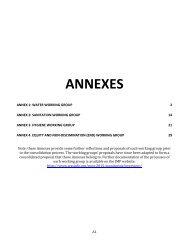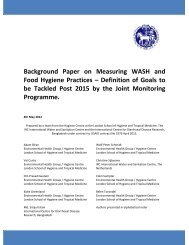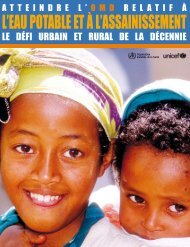rapid assessment of drinking-water quality in the republic of tajikistan
rapid assessment of drinking-water quality in the republic of tajikistan
rapid assessment of drinking-water quality in the republic of tajikistan
Create successful ePaper yourself
Turn your PDF publications into a flip-book with our unique Google optimized e-Paper software.
Microbial parameters. This <strong>in</strong>volves tak<strong>in</strong>g heterotrophic plate counts, as well test<strong>in</strong>g for <strong>in</strong>dicator<br />
organisms such as Escherichia coli (“coli <strong>in</strong>dex”) and faecal streptococci. Fur<strong>the</strong>r <strong>in</strong>vestigations <strong>of</strong><br />
specific pathogenic organisms are carried out as necessary.<br />
Physical and chemical parameters. This <strong>in</strong>volves measur<strong>in</strong>g basic <strong>water</strong> <strong>quality</strong> and organoleptic<br />
parameters (e.g. taste, odour, colour, turbidity, pН, temperature, residual chlor<strong>in</strong>e), as well as levels<br />
<strong>of</strong> selected potentially toxic chemicals such as nitrates, various metals, chlorides, sulfates, iron,<br />
copper and fluoride.<br />
At <strong>the</strong> time <strong>of</strong> this study, many laboratories were unable to follow standard procedures for <strong>water</strong><br />
<strong>quality</strong> sampl<strong>in</strong>g and analysis, ow<strong>in</strong>g to a lack <strong>of</strong> f<strong>in</strong>ancial, technical and tra<strong>in</strong>ed human resources.<br />
Although <strong>the</strong> laboratories <strong>of</strong> <strong>the</strong> Republican and oblast SESs had basic equipment for <strong>water</strong> <strong>quality</strong><br />
analysis, most <strong>of</strong> <strong>the</strong> equipment <strong>in</strong> <strong>the</strong> rayon SESs was outdated or did not work. Most <strong>of</strong> <strong>the</strong> rayon<br />
laboratories lacked adequate transportation, communication equipment and staff tra<strong>in</strong>ed <strong>in</strong> <strong>water</strong><br />
<strong>quality</strong> sampl<strong>in</strong>g and analysis. For <strong>the</strong>se reasons, <strong>the</strong> ability and capacity <strong>of</strong> <strong>the</strong> rayon labs to carry<br />
out <strong>water</strong> <strong>quality</strong> analysis <strong>in</strong> rural areas was generally limited, and thus most <strong>of</strong> <strong>the</strong> current <strong>water</strong><br />
<strong>quality</strong> data for Tajikistan focused on utility piped supplies <strong>in</strong> urban centres. The overall situation<br />
made it difficult to survey and monitor <strong>dr<strong>in</strong>k<strong>in</strong>g</strong>-<strong>water</strong> <strong>quality</strong> <strong>in</strong>dependently, to prevent <strong>in</strong>fectious<br />
disease outbreaks and to improve sanitary conditions.<br />
The responsibility for sanitary <strong>in</strong>spections belongs, by law, Provision <strong>of</strong> sanitary epidemiological<br />
safety to <strong>the</strong> population (2004), to <strong>the</strong> rayon SESs. Surveillance is to be carried out by “preventive”<br />
and “scheduled” sanitary <strong>in</strong>spections. Dur<strong>in</strong>g <strong>the</strong> design, construction and commission<strong>in</strong>g <strong>of</strong> a <strong>water</strong><br />
supply, for example, regular <strong>in</strong>spections are carried out to prevent <strong>the</strong> development <strong>of</strong> conditions that<br />
would lead to poor sanitary conditions. Regularly scheduled sanitary <strong>in</strong>spections are to be undertaken<br />
quarterly to assess <strong>the</strong> sanitary condition <strong>of</strong> a <strong>water</strong> supply dur<strong>in</strong>g operation. Currently, most rayon<br />
SESs are not <strong>in</strong> a position to carry out any sanitary <strong>in</strong>spections, ma<strong>in</strong>ly ow<strong>in</strong>g to a lack <strong>of</strong> staff (i.e.<br />
sanitary doctors) and transportation.<br />
The ma<strong>in</strong> responsibility for data collection, storage and analysis belongs to <strong>the</strong> SESs at <strong>the</strong> different<br />
adm<strong>in</strong>istrative levels (i.e. oblast SESs collect <strong>in</strong>formation from rayon SES, and <strong>the</strong> Republican SES<br />
collects data from oblast SESs). All records are generally handwritten and stored as paper files,<br />
which are <strong>of</strong>ten lost ow<strong>in</strong>g to improper storage. The lack <strong>of</strong> electronic equipment, particularly at <strong>the</strong><br />
rayon and oblast level, makes data analysis difficult and time consum<strong>in</strong>g. It is impossible to establish<br />
an electronic database, for example, which means that <strong>the</strong> paper <strong>in</strong>formation can only be accessed by<br />
personnel <strong>in</strong> <strong>the</strong> government agency deal<strong>in</strong>g with <strong>water</strong> <strong>quality</strong> issues. Currently, <strong>the</strong>re are no plans<br />
to share <strong>the</strong> <strong>in</strong>formation with <strong>the</strong> general public through <strong>the</strong> mass media (such as <strong>the</strong> <strong>in</strong>ternet) because<br />
<strong>the</strong> technical facilities do not exist.<br />
Historical <strong>water</strong>-<strong>quality</strong> data<br />
In recent years, <strong>dr<strong>in</strong>k<strong>in</strong>g</strong>-<strong>water</strong> <strong>quality</strong> <strong>in</strong> Tajikistan has been deteriorat<strong>in</strong>g. Many <strong>of</strong> <strong>the</strong> utility piped<br />
supplies break down frequently and service can be <strong>in</strong>termittent; both phenomena adversely affect <strong>the</strong><br />
microbial content <strong>of</strong> <strong>the</strong> <strong>dr<strong>in</strong>k<strong>in</strong>g</strong>-<strong>water</strong>. The extent <strong>of</strong> <strong>the</strong> problem can be seen from <strong>the</strong> data <strong>in</strong> Table<br />
1.3 for utility piped <strong>water</strong> supplies dur<strong>in</strong>g <strong>the</strong> years 20012004. In 2004, for example, 33.5% <strong>of</strong> <strong>the</strong><br />
<strong>water</strong> <strong>quality</strong> samples tested did not meet <strong>the</strong> national standard for E. coli.<br />
The deterioration <strong>in</strong> <strong>the</strong> chemical <strong>quality</strong> <strong>of</strong> <strong>water</strong> has been ma<strong>in</strong>ly attributed to a decl<strong>in</strong>e <strong>in</strong> source<br />
protection measures and sanitary conditions. In 2004, for example, 46% <strong>of</strong> <strong>water</strong> samples tested did<br />
not comply with national standards for one or more <strong>of</strong>: residual chlor<strong>in</strong>e, nitrate, sulfate, ammonia,<br />
hardness and metals (Table 1.4).<br />
In 2001, <strong>the</strong> Republican SES, with support <strong>of</strong> <strong>the</strong> WHO and <strong>the</strong> Federal Environmental Agency,<br />
Germany, carried out a countrywide survey to assess <strong>the</strong> level <strong>of</strong> organochlor<strong>in</strong>e <strong>in</strong>secticides <strong>in</strong> Tajik<br />
<strong>dr<strong>in</strong>k<strong>in</strong>g</strong>-<strong>water</strong> sources (Schmoll, 2002). Historically, <strong>the</strong> country witnessed an <strong>in</strong>tense use <strong>of</strong><br />
pesticides, particularly <strong>in</strong> cotton grow<strong>in</strong>g areas, but <strong>in</strong> <strong>the</strong> 1990s <strong>the</strong>re was a sudden drop <strong>in</strong> pesticide<br />
use. However, no current data were available on pesticide levels <strong>in</strong> Tajik ground<strong>water</strong> and surface<br />
<strong>water</strong>s used for <strong>dr<strong>in</strong>k<strong>in</strong>g</strong>-<strong>water</strong>. The Republican SES study showed that <strong>in</strong>secticide contam<strong>in</strong>ation<br />
was widespread, with 86% <strong>of</strong> <strong>the</strong> 110 sites <strong>in</strong>vestigated hav<strong>in</strong>g concentrations <strong>of</strong> one or more<br />
5


